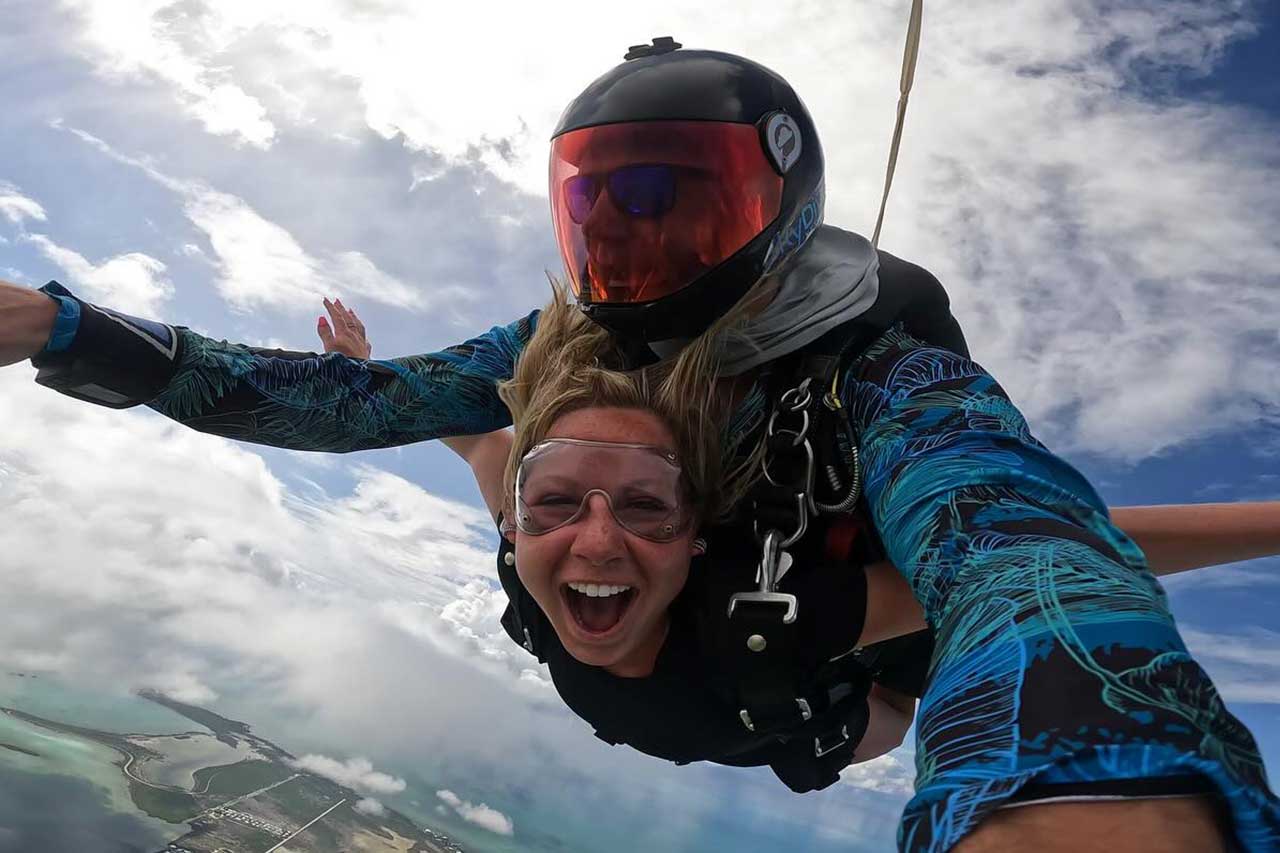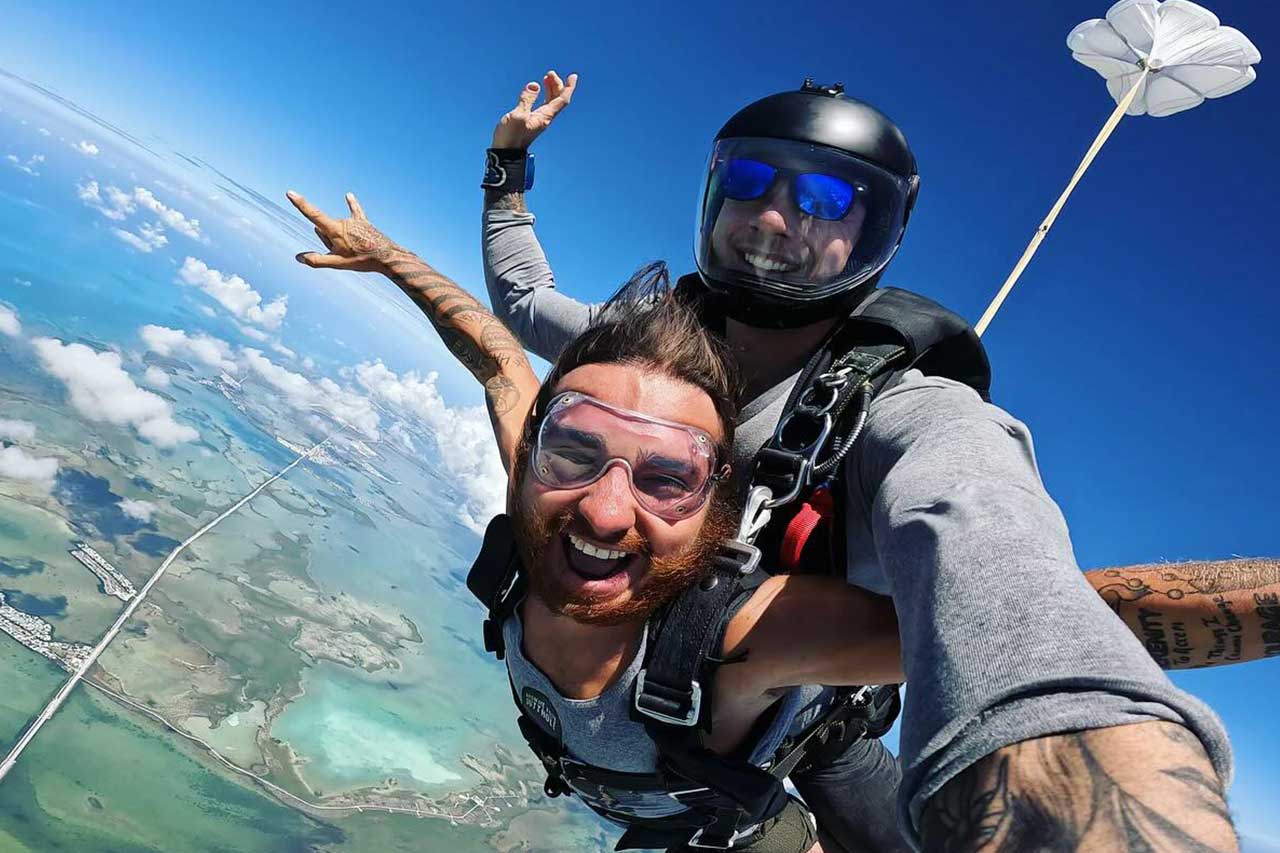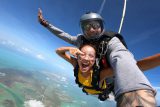How High Do You Skydive From?
Skydiving
Posted by: Skydive Key West
11 months ago
It’s jump day. You’re gearing up, the sun is warming your skin, the waters are shimmering, and the light ocean breeze is giving you a taste of the sky-high winds to come. You have awesome dinner plans and a sunset on the beach planned. In short, you’re having the time of your life. Then your heart starts racing and one question begins floating through your mind: how high do you skydive from?
We wish we could give you a straight up and simple answer, but the truth is: skydiving height is dependent on a few factors, which we’ll dive right into below.
What height do we jump from here at Skydive Key West? About 10,000 feet, AKA the skydiving sweet spot!

What Height Do You Skydive From: Factors To Consider
How high up do you skydive from? It depends on who you are and what type of jump you’re doing! For example, tandem skydivers are required to jump from higher altitudes than skydivers who have their solo skydiving license. Here at Skydive Key West, we exclusively tandem skydive. Tandem jumping is the perfect way to be introduced to the sport and allows people to check a big ol’ item off of the bucket-list!
When determining the altitude of a skydive, understanding the parameters of the aircraft, weather conditions, experience level of the jumper, and purpose of the jump, are all factors to consider.
Type of aircraft.
The climb rate, engine power, and fuel capacity of an airplane all determine how high it can efficiently ascend. We proudly jump Cessna 182s – a legendary skydive plane. These planes are known for their reliability and efficiency. They quickly climb to around 10,000 feet, offering the prime skydiving height for both tandem and solo jumpers.
Weather.
We are fortunate to live in the Sunshine State where the weather gods constantly bless us with gorgeous golden rays! BUT, sometimes they put a damper on skydiving operations. How does this affect how high you jump from skydiving? The height of the cloud base!
Obviously we aren’t jumping in thunderstorms or hurricane-level winds, but a few clouds (as long as we aren’t soaring through them) are generally fine. We are required to exit the airplane no less than 500 feet below the cloud base, ensuring adequate visibility in all directions. This means if the clouds are at 5,000 feet, licensed and qualified skydivers (read: not tandem skydivers) can still send low-altitude jumps called hop ’n pops from 4,500 feet.
Experience level.
Jumpers with different experience levels are able to jump from different altitudes. For example, someone looking to do a High Altitude, Low Opening (HALO) skydive must be licensed. Likewise, jumping from specialty aircraft, such as a helicopter or hot air balloon, requires jumpers to have certain qualifications and/or licenses.
Skydive purpose.
One way skydivers place safety first is by being intentional about learning something on every single skydive. Hop ’n pops are ideal for focusing on parachute flight, while a full altitude skydive (meaning usually from 10,000 feet or so) gives jumpers the opportunity to practice freefall and canopy skills.

What Is The Safest Height To Skydive From?
Let’s use another example, because once again – it depends! Skydiving from a low altitude, such as 4,000 feet AGL (Above Ground Level) is deemed acceptable for those who are licensed, but this would absolutely not be an acceptable height to jump from as a first-timer or tandem skydiver. The safest height to skydive from is one that fits the regulations set forth for your level of experience!
*Fun fact: The minimum height for tandem skydivers to exit at is 8,000 feet AGL.
How Long Does It Take To Skydive From 10,000 Feet?
The freefall time from 10,000 feet is about 40 seconds. Are you thinking, “OMG WHAT!? I thought I would get like five minutes of freefall?” Slow your roll buckaroo! Forty seconds is the ideal amount of time to freefall – it’s long enough to get past the “WHAT AM I DOING!?” shock, but short enough that you don’t get worn out.
Plus, it makes for amazing videos and photos, showcasing the stunning blue hues of the sky and ocean. Meaning, jumping from 10,000 feet is the *chef’s kiss* of skydiving altitudes.
What Is The Highest Altitude You Can Skydive From?
The highest tandem skydive from an airplane was from just over 40,000 feet – yes, FORTY THOUSAND! This allowed the jumpers to freefall for almost two and a half minutes. Although these specialty skydives are objectively awe-inspiring and showcase just how resilient humans are, they’re not everyone’s cup of tea. They cost thousands of dollars, require lots of extra gear and training, force you to endure frigid temps, and are generally just way more of a commitment than a regular skydive.
Is 10,000 feet in the sky calling your name? (We think so!) Book your tandem skydive now!




